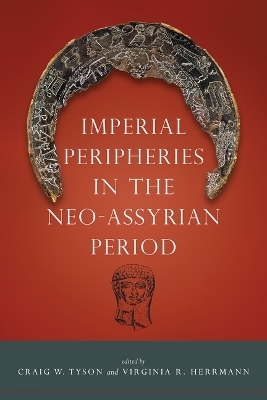
Imperial Peripheries in the Neo-Assyrian Period
Seiten
2019
University Press of Colorado (Verlag)
978-1-60732-991-6 (ISBN)
University Press of Colorado (Verlag)
978-1-60732-991-6 (ISBN)
- Lieferbar (Termin unbekannt)
- Versandkostenfrei innerhalb Deutschlands
- Auch auf Rechnung
- Verfügbarkeit in der Filiale vor Ort prüfen
- Artikel merken
Focuses on the variability of imperial strategies and local responses to Assyrian power across time and space.
Though the Neo-Assyrian Empire has largely been conceived of as the main actor in relations between its core and periphery, recent work on the empire’s peripheries has encouraged archaeologists and historians to consider dynamic models of interaction between Assyria and the polities surrounding it. Imperial Peripheries in the Neo-Assyrian Period focuses on the variability of imperial strategies and local responses to Assyrian power across time and space.
An international team of archaeologists and historians draws upon both new and existing evidence from excavations, surveys, texts, and material culture to highlight the strategies that the Neo-Assyrian Empire applied to manage its diverse and widespread empire as well as the mixed reception of those strategies by subjects close to and far from the center. Case studies from around the ancient Near East illustrate a remarkable variety of responses to Assyrian aggression, economic policies, and cultural influences. As a whole, the volume demonstrates both the destructive and constructive roles of empire, including unintended effects of imperialism on socioeconomic and cultural change.
Imperial Peripheries in the Neo-Assyrian Period aligns with the recent movement in imperial studies to replace global, top-down materialist models with theories of contingency, local agency, and bottom-up processes. Such approaches bring to the foreground the reality that the development and lifecycles of empires in general, and the Neo-Assyrian Empire in particular, cannot be completely explained by the activities of the core. The book will be welcomed by archaeologists of the Ancient Near East, Assyriologists, and scholars concerned with empires and imperial power in history.
Contributors: Stephanie H. Brown, Anna Cannavò, Megan Cifarelli, Erin Darby, Bleda S. Düring, Avraham Faust, Guido Guarducci, Bradley J. Parker
Though the Neo-Assyrian Empire has largely been conceived of as the main actor in relations between its core and periphery, recent work on the empire’s peripheries has encouraged archaeologists and historians to consider dynamic models of interaction between Assyria and the polities surrounding it. Imperial Peripheries in the Neo-Assyrian Period focuses on the variability of imperial strategies and local responses to Assyrian power across time and space.
An international team of archaeologists and historians draws upon both new and existing evidence from excavations, surveys, texts, and material culture to highlight the strategies that the Neo-Assyrian Empire applied to manage its diverse and widespread empire as well as the mixed reception of those strategies by subjects close to and far from the center. Case studies from around the ancient Near East illustrate a remarkable variety of responses to Assyrian aggression, economic policies, and cultural influences. As a whole, the volume demonstrates both the destructive and constructive roles of empire, including unintended effects of imperialism on socioeconomic and cultural change.
Imperial Peripheries in the Neo-Assyrian Period aligns with the recent movement in imperial studies to replace global, top-down materialist models with theories of contingency, local agency, and bottom-up processes. Such approaches bring to the foreground the reality that the development and lifecycles of empires in general, and the Neo-Assyrian Empire in particular, cannot be completely explained by the activities of the core. The book will be welcomed by archaeologists of the Ancient Near East, Assyriologists, and scholars concerned with empires and imperial power in history.
Contributors: Stephanie H. Brown, Anna Cannavò, Megan Cifarelli, Erin Darby, Bleda S. Düring, Avraham Faust, Guido Guarducci, Bradley J. Parker
Craig W. Tyson is associate professor of religious studies at D’Youville College in Buffalo, New York. He is author of The Ammonites: Elites, Empires, and Sociopolitical Change (1000–500 BCE) and several articles on the history and culture of ancient Jordan. Virginia R. Herrmann is a Junior Research Group Leader in the Institute for Ancient Near Eastern Studies at the University of Tübingen and co-director of the Chicago-Tübingen excavations at Zincirli, Turkey. She co-curated the 2014 Oriental Institute Museum exhibit In Remembrance of Me: Feasting with the Dead in the Ancient Middle East.
| Erscheinungsdatum | 23.09.2019 |
|---|---|
| Verlagsort | Colorado |
| Sprache | englisch |
| Maße | 152 x 229 mm |
| Themenwelt | Geschichte ► Allgemeine Geschichte ► Vor- und Frühgeschichte |
| Geschichte ► Allgemeine Geschichte ► Altertum / Antike | |
| Geisteswissenschaften ► Geschichte ► Regional- / Ländergeschichte | |
| Geschichte ► Teilgebiete der Geschichte ► Wirtschaftsgeschichte | |
| Sozialwissenschaften ► Politik / Verwaltung ► Politische Systeme | |
| Sozialwissenschaften ► Politik / Verwaltung ► Staat / Verwaltung | |
| ISBN-10 | 1-60732-991-3 / 1607329913 |
| ISBN-13 | 978-1-60732-991-6 / 9781607329916 |
| Zustand | Neuware |
| Haben Sie eine Frage zum Produkt? |
Mehr entdecken
aus dem Bereich
aus dem Bereich
auf den Spuren der frühen Zivilisationen
Buch | Hardcover (2023)
C.H.Beck (Verlag)
20,00 €
Konzepte – Methoden – Theorien
Buch | Softcover (2024)
UTB (Verlag)
39,90 €
Was Pompeji über uns erzählt
Buch | Hardcover (2023)
Propyläen (Verlag)
32,00 €


